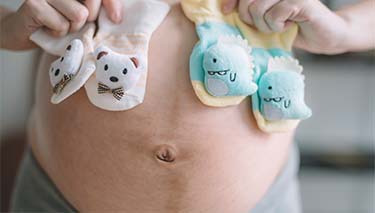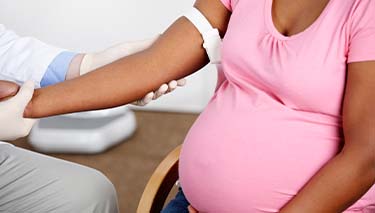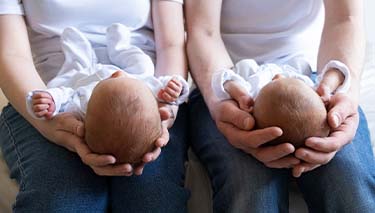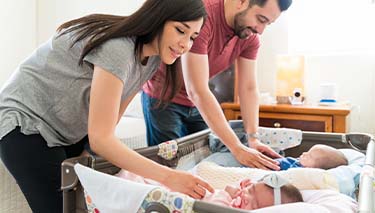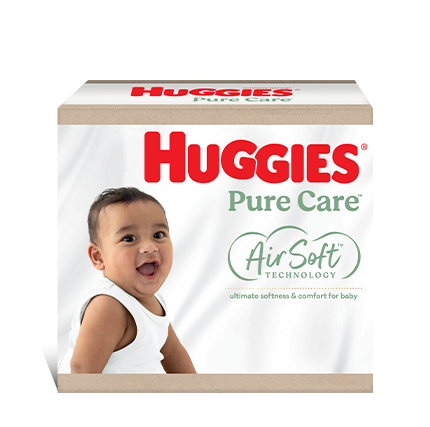When it comes to having a multiple pregnancy, twins are by far the most common. Around 90% will be made up of twins, with the remaining 10% being triplets, quadruplets, quintuplets and so on. Even if twins don’t run in your family, you could still have them; no fertile woman is immune. It’s estimated that as many as 5% of all pregnancies involve a twin at 12 weeks of gestation, but unfortunately, not all of these progress to term.
It’s important to remember that every pregnant mother is unique. Her experience of having a twin pregnancy may be very different to another woman’s – there is no one consistent set of experiences. Even when a woman has had a twin pregnancy before, the next one may be very different. Though something they will all share is a sense of anticipation and perhaps some worry for themselves and their twins.
Common twin pregnancy symptoms
- Earlier pregnancy symptoms than when pregnant with one baby. This is due to the high levels of HCG – Human Chorionic Gonadotrophin Hormone, which is responsible for many early pregnancy symptoms such as nausea and vomiting.
- Running to the toilet to wee more often. This is because the weight of the uterus sitting on top of the bladder. Until it lifts higher into the pelvis the full uterus doesn’t leave much room for much urine volume to collect before the bladder needs to be emptied.
- Lots of foetal movements, early “quickening” and fluttering movements; perhaps even earlier than 15 weeks.
- Showing earlier than normal. Mothers who are pregnant with twins tend to look pregnant earlier than those who are carrying one baby. So instead of the uterus lifting up and out of the pelvis after 12 weeks or so, it tends to grow much faster.
- Later in the pregnancy, the mother can experience respiratory symptoms because she can’t breathe as easily. This is because the twins have grown so much that they start to occupy the space in which her lungs would normally expand.
- Varicose veins, haemorrhoids, aching legs, fluid retention and difficulty walking.
How different is a twin pregnancy?
A twin pregnancy can be very different to a pregnancy involving only one baby. Every pregnancy symptom can be exacerbated, every twinge and niggle doubled and likelihood of complications increased as well. But just because you’re carrying two babies does not mean you will automatically have problems – many mothers of twins have a fabulous pregnancy and say they really enjoyed it. Although it does mean that you, your pregnancy and the growth of your babies will be carefully monitored by your health care professionals.
Until you have an ultrasound, you may not know if you are pregnant with monozygotic (identical) twins or dizygotic (non-identical) twins, though this should not really make a difference to your pregnancy symptoms. But it may influence the risks of twin pregnancy complications.
One of the factors which increase the odds of conceiving with twins is increasing maternal age. For older mothers who have other children, then your experience of a twin pregnancy may be very different to a mother who is younger and pregnant for the first time. Tiredness and fatigue can be all encompassing during any pregnancy, but this is especially the case when a mother is carrying two babies. Being able to lie down and rest may just not be an option when there are other small children in the household to care for.
Complications of twin pregnancy
The risks to pregnant mothers and their babies is a lot higher with twin rather than singleton pregnancies. These risks tend to increase with every week of gestation as the babies grow bigger and the mother’s body adjusts to the demands of a twin pregnancy.
- Miscarriage of one or both twins.
- Premature birth. This is much more common during twin pregnancy. It is estimated that less than 50% of all twin pregnancies extend beyond 38 weeks.
- Abnormalities in the twins – though this is more common in monozygotic (identical) twins than dizygotic (non-identical) twins.
- Conjoined twins – though parents are usually advised of this when there is a diagnosis during pregnancy ultrasound.
- Small for gestational age or intra uterine growth restriction. Twins are generally much smaller and lighter in birth weight than singleton babies of the same gestational age.
- Increased risk of needing to have a caesarian section delivery or an assisted delivery, including the use of forceps or vacuum extraction. Mothers who have a vaginal delivery with twins generally need to have an epidural and an episiotomy. This is because the birth needs to be controlled by the doctor and midwife so that complications are minimised. Vaginal birth is only considered if the first twin is cephalic (head down) and the second twin is not significantly bigger e.g. 500 grams heavier than the first twin.
- Twin to twin transfusion syndrome (TTTS). This is when one twin becomes bigger than the other because there is an uneven sharing of blood flow between them. The likelihood is around 15% of monozygotic twins will have some degree of TTTS.
- Death of one of the twins. This can occur at any stage of the pregnancy but the period of highest gestational risk is within the first and third trimesters.
- There is an increased risk of developing gestational diabetes, pre-eclampsia and pregnancy induced hypertension (PIH), polyhydramnios (extra amniotic fluid) and iron deficiency anaemia.
- Cord prolapse and presentation. This is what happens when the cord presents before the baby and there can be a cutting off of the blood flow to one or both of the babies.
Extra care during twin pregnancy
You will probably find that you have more ultrasounds and checkups during your twin pregnancy than if you were carrying one baby. The foetal screening scan at 18 weeks will be more thorough and time consuming, especially if the babies are not being cooperative by lying in the best positions to be able to see them both clearly. You may also need to have Doppler studies to examine the blood flow through each of the baby’s umbilical cords.
The amniotic fluid volume will also need to be monitored as this is one way of ensuring the babies kidneys are working effectively.
Twins generally grow at the same rate as singleton babies until they are between 32 and 35 weeks. After this stage of gestation, space becomes a real issue and there is simply not the room for them to grow at the same rate. By this stage, mothers who are pregnant with twins can start to become very uncomfortable and to feel as if they can’t move as easily as they’d like to. Stretch marks are also common in the third trimester when the collagen fibres in the skin tear because they cannot stretch anymore.
You may find you are confined to bed rest at home or admitted to hospital for monitoring. This is one way of being able to monitor blood pressure regularly and also in reducing the risk of premature birth.
If you are a negative blood group, you may need to have prophylactic Anti-D during your second and third trimesters at around 28 and 34 weeks. Be guided by your obstetrician about this; there is no one consistent approach which applies to all mothers.
If you are at risk of going into premature labour, you are likely to have at least one dose of corticosteroids. These help to mature the baby’s lungs so they are less likely to need breathing support when they are born.
What can I do during my twin pregnancy?
Because of the increased obstetric risks during a twin pregnancy, it’s easy for mothers themselves to feel overlooked. The focus of obstetric staff may be so concentrated on the pregnancy and twins that you could feel you as a person are going unnoticed. And although health professionals mostly try really hard not to do this, it can still happen. This is why it is so important for all pregnant mothers to advocate for themselves and have a say in their care. And to speak up if you feel you’ve become a “walking uterus” for hatching your twins!
- Look after yourself. Simple tasks such as eating healthy foods, getting rest and good quality sleep, regular exercise and maintaining healthy relationships is really important during any pregnancy. But they are all especially important when carrying two babies.
- You may benefit from seeing a dietician; check DAA – Dieticians Association of Australia. It’s important to ensure you have enough folate, protein, iron and nutrients to support sound pregnancy health.
- Make time to chill out. Your body is working 24 hours a day to grow and support two babies towards maturity. That means there will be times when you will feel tired even though you won’t consider you’ve done much.
- Think about finishing paid work earlier. You may find you are simply too tired to work past your second trimester. Investigate your leave entitlements with your HRM (Human Resource Management); you will need to get a doctor’s certificate for this so don’t leave it until you’re already exhausted. Plan early and let your bosses know you may be leaving earlier than other mothers who have applied for parental leave.
- Join the multiple birth association in your state. Go to some meetings before your twins are born and chat with the other parents. They can be an invaluable source of information and practical advice. Check Australian Multiple Birth Association.
- Speak with your health care provider about your birth options. Read what you can and ask lots of questions. Fear and anxiety can only be helped by being as informed as you can be.
- If you have older children, organise some regular, reliable and supportive care for them. Quarantining some time with your partner before the twins are born will help both of you to focus on strengthening your relationship.
Last Published* May, 2024
*Please note that the published date may not be the same as the date that the content was created and that information above may have changed since.


